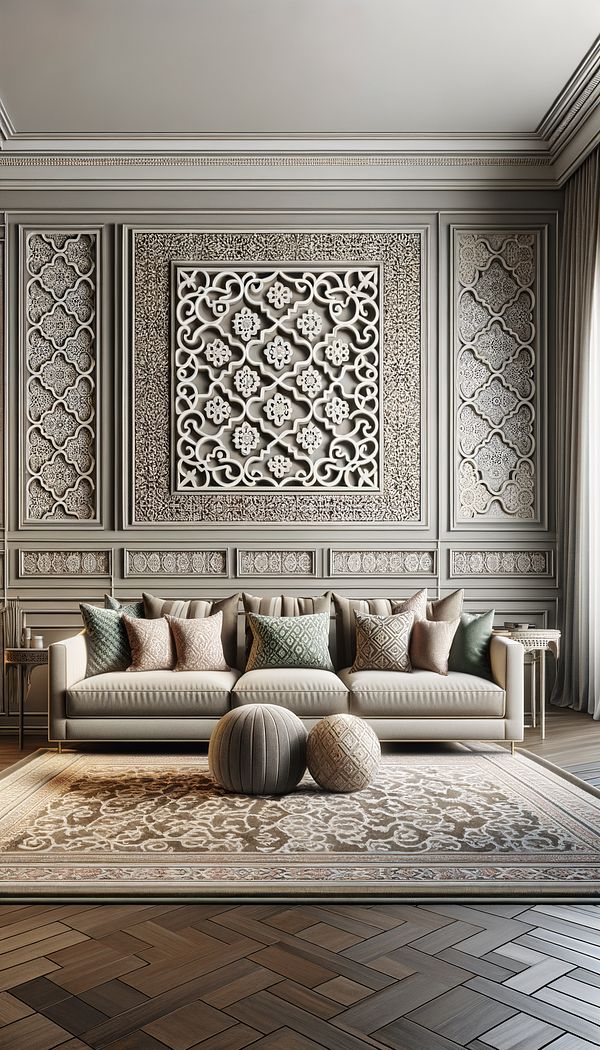What is a Quatrefoil?
A quatrefoil is a decorative element consisting of a symmetrical shape which forms the overall outline of four partially overlapping circles of the same diameter.
Description
A quatrefoil, which means 'four leaves' in Latin, is an ancient design element that has been adopted in various cultures and periods throughout history. In essence, it resembles a four-leaf clover. The typical quatrefoil consists of four equally spaced circles that overlap each other in a symmetrical manner, creating a shape that combines both the geometry and organic curves often sought in design. This shape can be either simple, having clean and smooth borders, or complex, featuring intricate outlines and embellishments.
Quatrefoils have a longstanding history in ecclesiastical and architectural design, being prominently featured in Gothic and Renaissance architecture. They are often seen in tracery, which involves the stonework elements that support the glass in a Gothic window. Besides architecture, the quatrefoil motif has also been adapted into various design styles ranging from furniture to textiles, thus showcasing its versatility as a decorative element. This motif not only adds visual interest and elegance to a space but also carries with it cultural and historical significance.
In modern usage, quatrefoils are used in an array of interior design contexts, including but not limited to, fabric patterns, furniture decoration, wall coverings, and decorative objects. Their usage brings a blend of traditional charm and contemporary elegance, illustrating how historical elements can be repurposed to suit modern tastes.
Usage
In interior design, the quatrefoil shape is a versatile motif that can be incorporated in various ways. It can be seen embroidered on textiles and upholstery, laser-cut into furniture panels, carved into wooden doors, or printed onto wallpaper and fabrics. The symmetry and recognizable shape of the quatrefoil make it a popular choice for adding decorative detail in a manner that is sophisticated yet carries a hint of historical elegance. Whether employed in a minimalist and modern design scheme or a more traditional and opulent setting, the quatrefoil adds depth and interest to the space.
FAQs
-
Is the quatrefoil design specific to any particular period or style?
No, the quatrefoil motif transcends various periods and styles. While it has roots in medieval and Renaissance art and architecture, it is versatile enough to be adapted into modern design contexts, making it timeless.
-
Can the quatrefoil motif be found in any specific type of decorative object?
Yes, the quatrefoil motif is adaptable and can be found in a wide range of decorative objects, including but not limited to, lamps, mirrors, throw pillows, and even in the design of jewelry.
-
Is there a symbolic meaning behind the quatrefoil shape?
Historically, the quatrefoil has been associated with several symbols, including harmony, symmetry, and good fortune. In Christian symbolism, it can represent the four evangelists or the four cardinal virtues, adding a layer of meaning to its use in designs.
Practical Application
When incorporating the quatrefoil design into your space, consider its placement and scale carefully. A large-scale quatrefoil pattern on a feature wall can create a bold statement, while smaller, repeated motifs on textiles or decorative objects can add subtle elegance. Its versatile nature allows for both bold and understated applications, making it important to balance its use according to the space's overall aesthetic and your desired end result. Be mindful of the cultural and historical connotations of the quatrefoil, which can add depth and narrative to your design.
-
Architectural Elements199 articles
-
Design Styles478 articles
-
Decorative Techniques322 articles
-
Decorative Objects240 articles
-
Textiles & Upholstery252 articles
-
Tight-Back SofaA tight-back sofa is a type of couch that has a fully upholstered back without any loose cushions.
-
AbacusAn abacus is a flat slab forming the top of a column capital.
-
CoverletA coverlet is a lightweight, decorative bedspread.
-
Byzantine ChairA Byzantine chair is a style of decorative, often ceremonial seating that originates from the Byzantine Empire era.
-
End MatchingEnd matching refers to a technique used in the installation of wood flooring and paneling.
